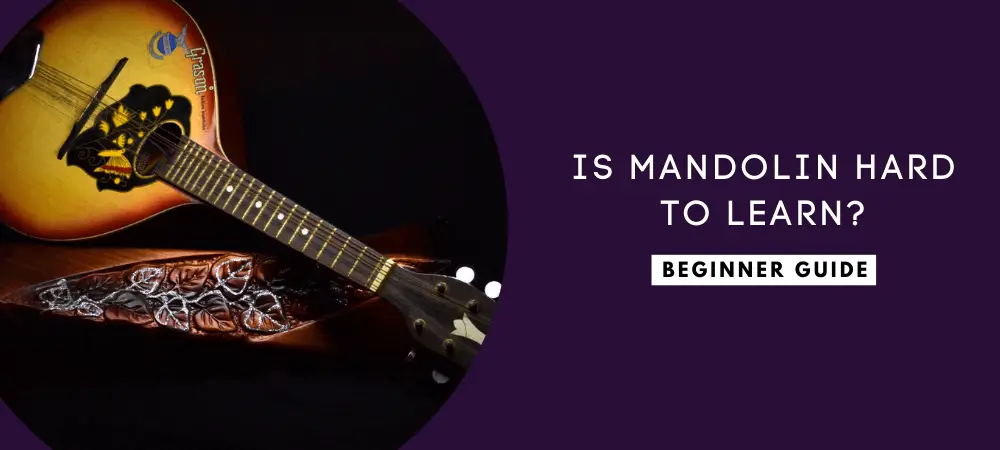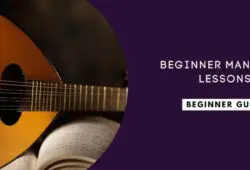Is mandolin easy, or is it a hard instrument to learn?
This has been a long-standing debate with aggressive proponents on either side of the argument.
While some people may find the mandolin to be an easy instrument, the fact is that there are a few factors that could make this small instrument quite challenging for new players.
Let’s take a look at what these factors are, shall we?
Table of Contents
How Hard Is It Really To Learn Mandolin Compared To Other Instruments?
-
Playing Double Strings
Tablature for mandolin reads just like for any other 4-stringed instrument.
The challenge comes in whereby you will have to press two strings on the mandolin to play one note. This is unlike other stringed instruments whereby each string plays a single note.
At the same time, the 8 steel strings on a mandolin are strung at a much higher tension. This is in part because of the short neck.
-
Higher String Tension
Higher string tension means that a mandolin player will struggle to push down the strings to play the mandolin. As you would imagine, this exerts more pressure on the beginner’s fingers, resulting in quite a bit of finger pain and discomfort while playing mandolin.
Many mandolin players struggle with acquiring the hand strength required initially, which is actually one of the most challenging aspects of learning mandolin.
Depending on the frequency of your mandolin playing, it could take a long while before developing calluses to harden the fingertips.
-
Smaller Instrument
The size of the instrument is the other challenge whereby you are working with a smaller fretboard than you would on other stringed instruments such as the guitar, for instance.
In addition to the small fretboard, keep in mind that playing the mandolin requires the mandolin player to be accustomed to holding double strings.
On the one hand, this is problematic for players with large hands because they have to squish their fingers to play a note. On the other hand, this is also an issue for players with particularly small hands because they will struggle to reach both strings to sound a note.
Some notes are more challenging than others, of course. For instance, playing a full ‘G’ chord requires a 6 fret stretch!
-
Unique Pick Holding
One unique aspect of playing the mandolin is how the player is required to hold the pick.
There are plenty of stringed musical instruments that involve using a pick. However, how you hold the pick when playing the mandolin is different from how you hold it to play any other instrument.
To produce quality sound, your right hand should be extremely loose while holding the pick. The idea is to grip it just tightly enough so that the pick stays in your hand, but it should always be in danger of falling out.
It sounds rather counterintuitive, doesn’t it? To play mandolin well, looseness is the main emphasis.
A good tip for beginners is to always keep a flat pick with you. Every so often, just hold it in your hand in the picking position so that you get used to the feel of it.
Also, while holding the pick, practice a pendulum-type of motion with your wrist, waving your hand around and shaking your wrist gently. The idea is to have the pick almost dropping from between your fingers, but not.
A looser grip is required when strumming chords in order for the pick to glide smoothly across each string.
A firmer grip is required when stemming single notes to completely drive through the double strings to produce a fuller note.
If beginners fail to keep their right hand extremely loose, they will experience hours of pain in the wrist, but particularly so in the elbow.
-
Unique Playing Techniques
To play the mandolin, you have to master both right-hand and left-hand techniques.
There are a lot of movable chord shapes and triads in mandolin music. Not to mention the numerous mandolin methods such as chops, tremolo, cross-picking, string skipping etc..
There are two key rules to keep in mind to learn to play using the various techniques and methods.
Rule number one is to play with alternating pick strokes, meaning down-up-down-up etc.
Rule number two is to play both strings on each stroke, meaning driving through each pair of strings using both upstrokes and downstrokes.
This sounds easy enough, but it can be pretty difficult when you start playing the mandolin.
-
Finding A Good Mandolin Teacher
The final challenging bit about learning mandolin compared to learning other musical instruments is how hard it is to find a good mandolin teacher.
The mandolin isn’t very popular, so it is quite challenging to find a tutor who will guide you in one-on-one lessons as you learn mandolin playing.
Without a good teacher, it becomes really easy to develop bad habits in the form of poor techniques. Worse still, you will not know that you are doing it wrong because you won’t have anyone to correct you and train you on the proper technique.
How Long Does It Take To Learn Mandolin?
Acquiring a musical skill on a new instrument is never easy. It requires a good deal of interest and drive to keep you consistent with practice lessons and frequent playing to hone your skills.
The more you play the new instrument, the more you develop your skillset, to a point where playing it will come very naturally to you.
That being said, it will obviously take a shorter time to learn an easy instrument than it would to learn a more challenging instrument.
So how long does it take to learn the mandolin?
If you dedicate about an hour of practice lessons every day, it will take you approximately 3 months to acquire the necessary skills to play the instrument confidently.
Nevertheless, mastering the mandolin to the level at a professional mandolin player’s level takes many years and even decades of grueling practice lessons. Some players spend even a lifetime honing their craft. So don’t rush it.
Practice slowly, consistently, and regularly and with time, your hard work will show.
Tips To Make Learning Mandolin Easier For You
- Using light gauge strings at first will make it easier as you learn to play the mandolin. Of course, this will result in less volume, but you will be able to play more comfortably with reduced pain in your fingers.
- A good mandolin set-up is a crucial aspect of good playability. In the beginning, it will serve you well to keep your action as low as possible, without string buzz. Then you can raise your action over time to achieve a fuller sound.
- Choose a mandolin that’s best suited to your musical style. Mandolins are designed with different music genres in mind. Trying to play bluegrass music on a classical music mandolin will prove very frustrating, especially for beginners.
- Practice regularly every chance you get. Keep your mandolin nearby so you can squeeze in practice time as often as possible. The more you play, the easier it will get and the more you will enjoy your new instrument.
- Playing slowly using good technique is key to becoming a better mandolin player. It is harder than it seems, but once you can play slowly with perfect technique, playing fast and accurately will come naturally.
- Practice with a metronome. When it comes to playing the mandolin, timing is far more crucial than even playing the right notes. You would rather play the wrong note at the right time than play the right note at the wrong time.
- Record yourself while playing or during your lessons. This will give you a good idea of your progress, and it will also show you exactly what you sound like, rather than what you think you sound like.
- Find a good teacher or instructor to guide you. This will save you from developing bad strumming habits and will also make it easier for you to progress faster in learning the instrument.
FAQs About How Hard Is It To Learn Mandolin
Can You Teach Yourself Mandolin?
Yes, you can. However, it is not advisable.
It is possible to learn mandolin online through youtube videos or platforms such as Mandolin Cafe, which is a great resource.
Even if you have a background in music theory, it always helps to start out with a teacher because, as a beginner, you may overlook many basic mistakes you might be making on the mandolin.
With no one to correct and guide you through common pitfalls, you will end up developing poor techniques that will be nearly impossible to rectify down the line.
Try finding an affordable mandolin tutor that can give you private lessons either online or in person.
Is Mandolin Harder Than Guitar?
Yes, it is.
With a mandolin, you have to play double strings, which can be challenging even for the seasoned guitar player who is already callused.
At the same time, a mandolin is smaller than the typical acoustic guitar and requires more precise fretting than the latter.
While the mandolin is strung in fifths, like a fiddle, the guitar is strung in fourths. To play the mandolin, a guitar player will have to learn chord shapes all over again, even though they already did so while learning guitar.
Is It Easier To Learn Banjo Or Mandolin?
It is easier to learn the banjo.
Of all music playing instruments, the 5-string banjo is actually among the easiest to get started on because its standard tuning is the open ‘G’ tuning.
A banjo has lightweight strings, full-size frets, and each finger only plays one string. Also, a banjo has a gentler learning curve compared to a mandolin.
Conclusion
While starting on the mandolin, building your chops can be frustrating, and it may even appear impossible altogether.
However, you need to remember that producing a quality tone has more to do with accuracy than strength.
As long as you love mandolin music and are committed to learning the instrument, you will do just fine.






